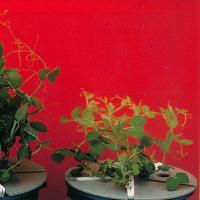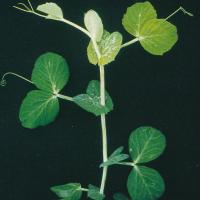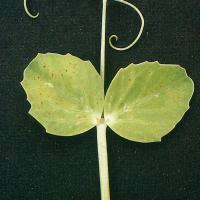Diagnosing sulphur deficiency in field peas
Sulphur (S) deficiency is rare in Western Australia as field peas are generally grown on heavy-textured soils.
What to look for
- Smaller plants with pale new growth.
- Deficiency is most likely in cold wet conditions on deep pale sands.
Paddock
- Growth and colour are affected simultaneously.
- New leaves and tendrils become evenly chlorotic.
- Randomly distributed light brown chlorotic spots develop on chlorotic leaves of severely deficient plants.
Plant
What else could it be
| Condition | Similarities | Differences |
|---|---|---|
| Diagnosing iron deficiency in field peas | Chlorotic young growth. | White new leaves. Plants are not stunted. Deficiency more likely on wet or limed soils. |
| Diagnosing group B herbicide damage in field peas | Chlorotic young growth. | Chlorotic young growth. |
| Diagnosing virus damage in field peas | Chlorotic young growth | Stunted plants; not soil type associated. |
| Diagnosing manganese deficiency in field peas | Chlorotic young growth | Leaf interveinal chlorosis and tendrils roll inwards and die back from the ends |
Where does it occur?

Soil type
- S leaches in high rainfall on sandy acidic soils.
- Cold, wet conditions slow sulphur mineralisation and plant uptake.
- S is as a component of organic matter, and sulphate is adsorbed on to clay, iron and aluminium oxides.
- Root restricting constraints such as traffic pans, disease or soil acidity will worsen S deficiency.
- In areas close to the sea or industrial pollution, there can be significant input of S from the atmosphere.
Management strategies
- Top-dressing S sources such as gypsum will correct the deficiency
- Foliar sprays generally cannot supply enough S to overcome a severe deficiency.
- Grain S removal (1.8 kg per tonne of grain), is a guide to long term requirements.
- Deeper soil testing may eliminate costly S fertiliser application.
- Root restricting constraints such as traffic pans, disease or soil acidity will worsen S deficiency and final yield, even if S is available further down the soil profile.
How can it be monitored?

Soil test
- Australian laboratory standards have not been established for field peas. A guide from literature for the top half of a shoot is 0.2%. Sample paired good and poor plants at the same growth stage.
- 0-10cm soil test (Blair S test in WA) is a poor guide for S, as plants can access S reserves at depth.
See also
Further information
Where to go for expert help
Page last updated: Wednesday, 13 May 2015 - 1:24pm




